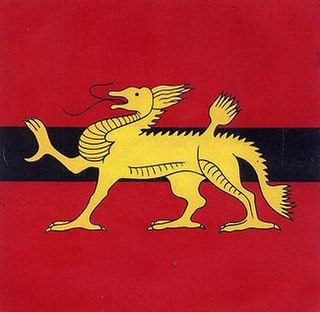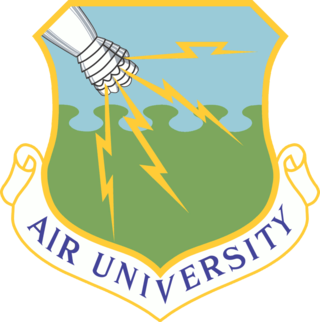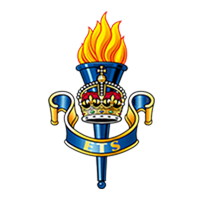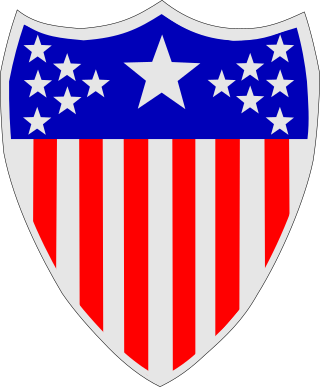History
1846–1914
On 2 July 1845 the Corps of Army Schoolmasters was formed, staffed by warrant officers and senior non-commissioned officers, as well as a few commissioned officers who served as inspectors and headmasters. [1]
In 1859 its duties were extended from simple schooling within the Army to assume responsibility for the Army schools and libraries [1] and in 1903 the Army schoolmasters fell under the jurisdiction of the Adjutant-General. [1] By the early 1900s, soldiers began to be admitted to evening classes, and some garrisons opened vocational classes. In 1914, a committee was set up for the "industrial training of soldiers", underlining the Army's intent to properly equip soldiers for civilian life. [1]
First World War
Despite the strains of the First World War on the British Army, education of soldiers did not stop. The British Army was circulated in and out of the front line, reserve line, and rest areas. This allowed education to continue, albeit in a disrupted fashion. Even whilst in the trenches, boredom meant the soldiery desired news and information, and thus officers would organise lectures to satisfy these needs. The issue of resettlement was also raised by the war, and so a scheme was established to prepare men for civilian life. [1] Under the Army Educational Scheme, soldiers who were educated by the Corps would receive a certificate of education. This certificate would then aid them in finding a job and competing with the thousands of other soldiers that would be demobilised and would also need a job once the war was over. [2]
1920–1939
A Royal Warrant established the Army Educational Corps on 15 June 1920. [1] The wartime task of its members was to "assist by all means in their power the maintenance of a high spirit of devotion and well being in their units". Peacetime duties were more clearly defined, and Army Educational Corps personnel were expected to do specialist and advisory work, with the bulk of the teaching to be done by regimental officers. [1] By 1938, Army Educational Corps recruits were required to be between 20 and 25 years of age. They had to be either qualified teachers or university graduates. They initially enlisted for twelve years and were immediately promoted Sergeant. [3]
Second World War
The Second World War saw the normal work of the corps radically change. The need for both physically and mentally competent troops resulted in an increased workload for the Army Education Centres. The AEC began to operate in a variety of different theatres and locations throughout the war, including the unexpected task of sending news-sheet teams with the D-Day landings. Recruits saw training time double, with education being conducted in hospitals, prisons and displaced persons camps. The end of the war saw the Corps involved in the daunting task of returning a national Army to civilian occupation. Unit Education Officers gave pre-release advice whilst the Corps organised an extensive network of "formation colleges". [4]
1946–1992
On 28 November 1946 the AEC was honoured with the title of "Royal". [1] In Britain this honour must be bestowed directly by the monarch, and allows the relevant service or organisation the right to use a representation of the crown in their badge. King George VI contributed to the design of the new badge. After the war the RAEC continued its work educating soldiers and helping them to resettle into civilian life. That same year, the responsibility of teaching the personnel's children was transferred to the newly formed British Families Education Service. [1]
From 1962 it was staffed exclusively by commissioned officers and the non-commissioned personnel were either commissioned or left the Army. [1]
In 1971, the education of soldiers was radically changed. Recruits joining the Army were generally poorly qualified and although the tasks of soldiering were easily mastered, the additional responsibilities involved in being an NCO proved more difficult. The new system introduced the Education Promotion Certificate. This was designed to specifically meet the training needs of potential Sergeants and Warrant Officers. [1]
In 1992 the RAEC lost its Corps status and became the Educational and Training Services Branch of the new Adjutant General's Corps. [1]

The Luxembourg Armed Forces are the national military force of Luxembourg. The army has been a fully volunteer military since 1967. As of December 2018, it has 939 personnel.

Brigade of Gurkhas is the collective name which refers to all the units in the British Army that are composed of Nepalese Gurkha soldiers. The brigade draws its heritage from Gurkha units that originally served in the British Indian Army prior to Indian independence, and prior to that served for the East India Company. The brigade includes infantry, engineering, signal, logistic and training and support units. They are known for their khukuri, a distinctive heavy knife with a curved blade, and have a reputation for being fierce and brave soldiers.

The Royal Military Police (RMP) is the corps of the British Army responsible for the policing of army service personnel, and for providing a military police presence both in the UK and while service personnel are deployed overseas on operations and exercises. Members of the RMP are often known as 'Redcaps' because of the scarlet covers on their peaked caps and scarlet coloured berets.

The Adjutant General's Corps is a corps in the British Army responsible for many of its general administrative services, named for the Adjutant-General to the Forces. As of 2002, the AGC had a staff of 7,000 people.

The Hong Kong Military Service Corps (HKMSC) was a British army unit and part of the British garrison in Hong Kong. Throughout the history of Hong Kong, it has been the only regular British army unit raised in the territory made up almost entirely of Locally Enlisted Personnel (LEP).

The Royal Army Pay Corps (RAPC) was the corps of the British Army responsible for administering all financial matters. It was amalgamated into the Adjutant General's Corps in 1992.

The Royal Army Ordnance Corps (RAOC) was a corps of the British Army. At its renaming as a Royal Corps in 1918 it was both a supply and repair corps. In the supply area it had responsibility for weapons, armoured vehicles and other military equipment, ammunition and clothing and certain minor functions such as laundry, mobile baths and photography. The RAOC was also responsible for a major element of the repair of Army equipment. In 1942 the latter function was transferred to the Royal Electrical and Mechanical Engineers (REME) and the vehicle storage and spares responsibilities of the Royal Army Service Corps were in turn passed over to the RAOC. The RAOC retained repair responsibilities for ammunition, clothing and certain ranges of general stores. In 1964 the McLeod Reorganisation of Army Logistics resulted in the RAOC absorbing petroleum, rations and accommodation stores functions from the Royal Army Service Corps as well as the Army Fire Service, barrack services, sponsorship of NAAFI (EFI) and the management of staff clerks from the same Corps. On 5 April 1993, the RAOC was one of the corps that amalgamated to form The Royal Logistic Corps (RLC).

Air University is a professional military education university system of the United States Air Force. It is accredited by the Commission on Colleges of the Southern Association of Colleges and Schools to award master's degrees.
The Royal Australian Army Educational Corps (RAAEC) is a specialist corps within the Australian Army. Formed in 1949, the corps had its genesis in other services that existed within the Australian forces during World War I and World War II. It is currently made up entirely of commissioned officers and is responsible for the provision of education-related services within the Army. Its various roles include instruction, designing computer-based learning materials, instructional systems, language training, literacy, and numeracy.

A military reserve force is a military organization whose members (reservists) have military and civilian occupations. They are not normally kept under arms, and their main role is to be available when their military requires additional manpower. Reserve forces are generally considered part of a permanent standing body of armed forces, and allow a nation to reduce its peacetime military expenditures and maintain a force prepared for war. During peacetime, reservists typically serve part-time alongside a civilian job, although most reserve forces have a significant permanent full-time component as well. Reservists may be deployed for weeks or months-long missions during peacetime to support specific operations. During wartime, reservists may be kept in service for months or years at a time, although typically not for as long as active duty soldiers.

The Educational and Training Services form part of the Adjutant General's Corps and have done since 1992 when this Corps of the British Army was formed. Their remit is to continue the general education of soldiers and officers alike, as well as the actual military training of the soldiers of the Army.

General Sir Ronald Forbes Adam, 2nd Baronet, was a senior British Army officer. He had an important influence on the conduct of the British Army during the Second World War as a result of his long tenure as Adjutant-General, responsible for the army's organisation and personnel, from June 1941 until the end of the war, and as a close confidant of Field Marshal Sir Alan Brooke, the Chief of the Imperial General Staff (CIGS), the professional head of the British Army.

The United States Army Air Forces during World War II had major subordinate Commands below the Air Staff level. These Commands were organized along functional missions. One such Command was the Flying Training Command (FTC). It began as Air Corps Flying Training Command on 23 January 1942, was redesignated Army Air Forces Flying Training Command (AAFTC) on 15 March 1942, and merged with Army Air Forces Technical Training Command to become Army Air Forces Training Command on 31 July 1943. Continuing service after the war, it was redesignated Air Training Command on 1 July 1946. During the consolidation of Air Force Major Commands in the retrenchment of the 1990s, Air Training Command assumed control of Air University and became Air Education and Training Command on 1 July 1993—today's Air Education and Training Command (AETC), which celebrated its 75th anniversary 23 January 2017. see the Lineage and honors statement for AETC.

The Royal Australian Army Dental Corps (RAADC) is a corps within the Australian Army. It was formed on 23 April 1943 during World War II as the Australian Army Dental Corps, before being granted the 'Royal' prefix in 1948. Prior to its formation dentists were part of the Australian Army Medical Corps. The role of the RAADC is to provide dental care to army personnel in order to minimise the requirement for the evacuation of dental casualties, to conserve manpower and to reduce the burden of casualty evacuation. In the post-war years, the corps has provided personnel to deployments in Japan, Korea and Vietnam. It has also contributed to peace-keeping operations in Somalia, Rwanda, Bougainville and East Timor.
The Soldier Support Institute (SSI) at Fort Jackson, South Carolina is a U.S. Army organization and major subordinate command of the Combined Arms Support Command and part of the Sustainment Center of Excellence (SCoE). It is also part of the Training and Doctrine Command (TRADOC).

The Adjutant General School and the Soldier Support Institute (SSI) are located at Fort Jackson, South Carolina. The school was formerly located at Fort Benjamin Harrison, Indiana, until its closure. These provide training and development of doctrine and organization for Army personnel and administrative operations. Along with the U.S. Army Forces Command (FORSCOM), United States Army Training and Doctrine Command (TRADOC) was created from the Continental Army Command (CONARC) located at Fort Monroe, VA on 1 July 1973. Today, TRADOC is the overseer of training of the Army forces, the development of operational doctrine, and the development and procurement of new weapons systems. The reconstructed Adjutant General Corp Regiment (AG) was created in 1987. The U.S. Army administration and finance specialists are trained at the Adjutant General School located at Fort Jackson. Today's AG Corps serves as human resource (HR) managers for the Army.

The Adjutant General's Corps, formerly the Adjutant General's Department, is a branch of the United States Army first established in 1775. This branch provides personnel service support by manning the force, providing human resources services, coordinating personnel support, Army band operations, and recruiting and retention. The objective of the Adjutant General Corps is to "maximize operational effectiveness of the total force by anticipating, manning, and sustaining military operations. HR support operations accomplish this by building, generating, and sustaining the force providing combatant commanders the required forces for missions and supporting leaders and Soldiers at all levels."

An officer is a person who holds a position of authority as a member of an armed force or uniformed service.
Lieutenant General Sir Gerald William Berragan, is a former senior British Army officer who has served as Adjutant-General.

The Royal Sardinian Army was the army of the Duchy of Savoy and then of the Kingdom of Sardinia, which was active from 1416 until it became the Royal Italian Army on 4 May 1861.














